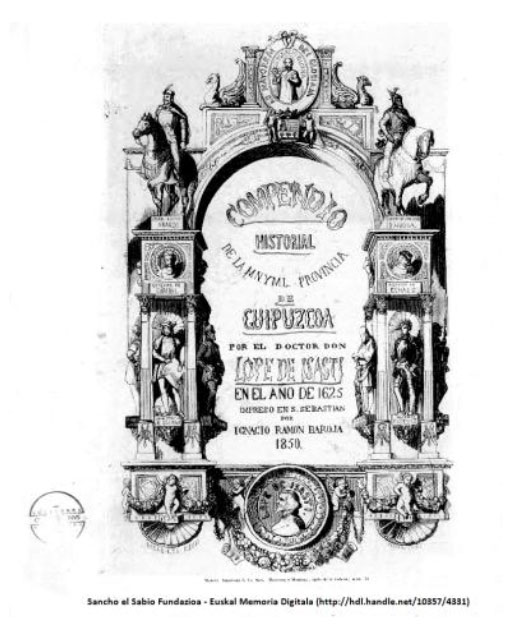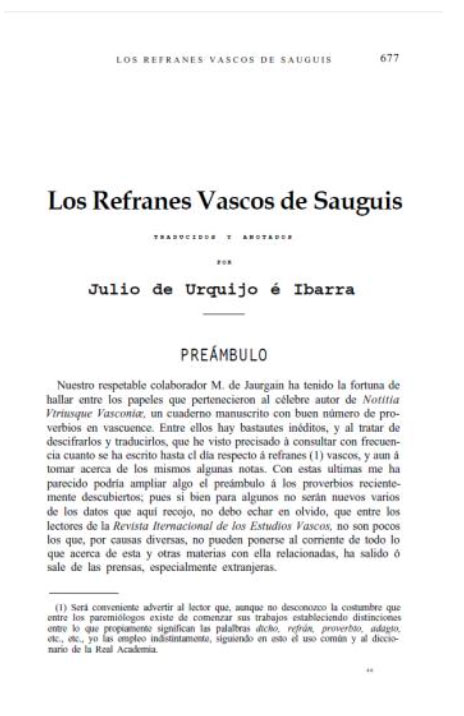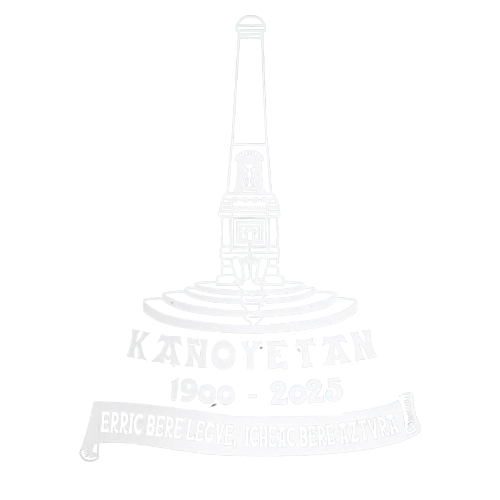"Caños" or "cañones"?
This is the great question regarding the origins of the name of this popular Donostiarra society, of which there is, however, no doubt that it was the first with an essentially gastronomic vocation.
Su sede, a prueba de agua si su denominación procede de la fuente contigua a su puerta, o a prueba de bomba si proviene del parque de artillería que ocupó el actual Museo San Telmo, antiguamente convento de frailes dominicos, sigue siendo la misma en la vetusta casona del Conde de Peñaflorida, restaurada y remodelada por la Kutxa para su Instituto del Dr. Camino (Biblioteca y Centro Cultural).
After 115 years as tenants and years of continuous negotiations with the property owner, "Kutxa" finally succeeded in becoming the owner of the premises it has occupied since its foundation, back in 1900.
This is the motto that welcomes us as we enter the Kañoyetan society from August 31 Street:
ERRIC BERE LEGUE, ICHEAC BERE AZTURA
Each country their law, each house its custom)
Apparently, throughout the 16th and 17th centuries, influenced by the Renaissance, the idea of collecting the works of popular literature (ballads, poems, legends... as well as proverbs, sayings, and maxims) spread across various European countries (including Spain and France). Proverbs and maxims (atsotitzak, errefrauak in Basque) were considered condensed pearls of popular wisdom. In the Basque Country, this interest also took root, and several authors from both sides of the Bidasoa, from Hegoalde (Southern Basque Country) and Iparralde (Northern Basque Country), devoted themselves to this arduous task. It is worth noting, in passing, that those who undertook these collections were clergymen and members of the nobility and aristocracy, who had the time to engage in cultural and research activities, as the common people were illiterate and had no time for anything other than working and striving to survive.

As early as 1625 (17th century), we have written evidence of the proverb that presides over the Kañoyetan society, provided by Lope Martínez de Isasti, with the same spelling as in the society: 'ERRIC BERE LEGUE, ICHEAC BERE AZTURA' (which translates into Spanish as 'Cada tierra su ley, cada casa su costumbre. En cada Villa su maravilla'—'Each land its law, each house its custom. In each town its wonder'). Isasti was a native of Lezo, a priest, and historian, and he includes it on page 173 of his work Compendio histórico de la muy noble y muy leal provincia de Guipúzcoa, written in 1625 but not published until 1850, at the printing press of Ignacio Ramón Baroja in San Sebastián. Logic suggests that the written recording of a proverb by an author is a sign that the proverb was sufficiently common and used among the people.
An author from the northern part of the country, the Souletin Bertrand de Sauguis or Zalgize, also documents it.
Little is known about this author, but in 1597 he was working in the service of the King of Navarre, and he is thought to have compiled the proverbs around the same time as Lope de Isasti. He was a relative of Arnaud de Oihenart, and the latter possessed an unpublished manuscript notebook of Zalgize's proverbs.
This manuscript was analyzed by Julio de Urquijo, and the proverbs were published in 1908 in the Revista Internacional de Estudios Vascos (RIEV 2, 5; 1908).
Our proverb appears on page 723, with number 189, and it differs from Isasti's version in several aspects:
“HERRIC BERE LEGUE, ETCHEC BERE AZTURA”.

As early as 1625 (17th century), we have written evidence of the proverb that presides over the Kañoyetan society, provided by Lope Martínez de Isasti, with the same spelling as in the society: 'ERRIC BERE LEGUE, ICHEAC BERE AZTURA' (which translates into Spanish as 'Cada tierra su ley, cada casa su costumbre. En cada Villa su maravilla'—'Each land its law, each house its custom. In each town its wonder'). Isasti was a native of Lezo, a priest, and historian, and he includes it on page 173 of his work Compendio histórico de la muy noble y muy leal provincia de Guipúzcoa, written in 1625 but not published until 1850, at the printing press of Ignacio Ramón Baroja in San Sebastián. Logic suggests that the written recording of a proverb by an author is a sign that the proverb was sufficiently common and used among the people.
Some curiosities...
This is the great question regarding the origins of the name of this popular Donostiarra society, of which there is, however, no doubt that it was the first with an essentially gastronomic vocation.
Su sede, a prueba de agua si su denominación procede de la fuente contigua a su puerta, o a prueba de bomba si proviene del parque de artillería que ocupó el actual Museo San Telmo, antiguamente convento de frailes dominicos, sigue siendo la misma en la vetusta casona del Conde de Peñaflorida, restaurada y remodelada por la Kutxa para su Instituto del Dr. Camino (Biblioteca y Centro Cultural).
After 115 years as tenants and years of continuous negotiations with the property owner, "Kutxa" finally succeeded in becoming the owner of the premises it has occupied since its foundation, back in 1900.
It may be true that, having been a matriarchy for centuries, the creators of the popular societies in Donostia sought within them a way to elude the yoke of the dominant gynocracy. A futile effort. Fleeing from the etxekoandre (If that was the case) they fell into the trap of gizartekoandre, that is, that admirable woman (like the home, sweet home) who takes care of the hygiene and cleanliness of the society, the kitchen and its utensils... and the well-being of the members themselves. There have been, are, and will be employees of the popular societies transformed into true social institutions, and some, even into real 'institutrices' of the boys under her care and protection.
Adán Etxekalte escribió en los años 30 que “en San Sebastián, cuando se habla de la Concha, es preciso especificar si se trata de la playa o de la (mujer) de Gaztelupe". Well, from the cooks of Kainoieta (since the employee of a gastronomic society is predominantly a culinary employee) two of them have gone down in history: La JoshepaJosefa Urquía, to whom, on 24 March 1931, the members paid a warm tribute, celebrated in style in the rooms of Agustín Guruceta's Hotel Príncipe, with telegrams of support (one from Machaquito), and information in the local press and all the fishing.
In the magazine published by the society in 1992, when the new drum Kainoieta was launched, it said: ‘For more than thirty years, Elena Goyeneche has been mistress and mistress of the society's kitchens and cooking pots. For this Navarrese from Bera in Bidasoa, the art of cooking seems to have no secrets. She had to replace another great cook, Joshepa, who also marked an era in Kainoieta. She retired just over ten years ago, but her pil-pil cod or stuffed hake, some of her most famous dishes, are still in the memory and on the palate of those who had the good fortune to taste them’.
There have always been physician-gastronomers, to whom Camba dedicated an essay, La gula hipocrática (The Hippocratic Gluttony), a kind of gluttony that has a fair share of hypocrisy, in that some of those who practice it often prohibit it to their patients.
There were doctors at the birth of Kañoyeta, not necessarily gynecologists. There was Dr. Valderrama, assisting with the delivery. Dr. Polit was president of the society, where his colleagues Agustin Anza, Ignacio Galdos, and Joxé Larburu were active (especially if there was bullabesa, a Basque fish stew). Fernando Asuero, the one with the trigeminal nerve, frequently attended 'Cañones' before and after his (honest) work on the noses of his patients on both shores of the Atlantic. By the mid-century, Luis Alzua was leading a gathering with plenty of sauce (green, not due to the tone of the conversation, but because of the actual substance that accompanied the dish).
Kokotxas (hake cheeks), hake, cod... alongside distinguished physicians of great ingenuity and knowledge such as Juan Mari Arrillaga, Carmelo Balda, Fernando Castañeda, Luis Irizar, Aurelio Maeso, José Luis Maíz, and Genaro Mañeru."
Around the same time, perhaps earlier, a long tradition began with a dinner attended by the late writer and doctor Luis Martín Santos, along with doctors José León Careche, Enrique Cormenzana, Mariano Arrazola, and Vicente Urcola, as well as members from different academic backgrounds such as the Miangolarra brothers and Joaquín Pradera.
From Joaquin Pradera comes the direct testimony of two dinners, on successive Wednesdays, at which he accompanied the philosopher José Ortega y Gasset with his son, a doctor like Julián Bergareche and the aforementioned Urcola, Julio Caro Baroja, sculptor Sebastián Miranda, Gregorio Marañón Moya, and the multifaceted and ever-witty Santos Echeverría. And to round off the gastronomic feast with oxtail stew, another Ortega, Domingo Ortega, the wonderful bullfighter...
Today, the doctor and surgeon Eduardo Ayestarán is the standard-bearer of this tradition, in his case not only of gastronomic passion, but of culinary... oops! I mean, surgical intervention
In addition to the 'Kokotxas' of the queen, the emblematic dish of Kañoyeta, the best fish soup in the world (in fraternal competition with that of the now-defunct Casa Víctor on Pescadería Street), was made by Tomás Bejarano, janitor of the Choir Donostiarra and an Christ. He was said to have been the most notable bon vivant of the city, but he only made an impression during the rehearsals and concerts of the choir. His culinary refinement spread by word of mouth, making mouths water, although only a very few had the fortune of directly tasting his delicacies. Another great cook was Juan José Cuende, who
invented the 'a duriz' dinners, a banquet for five pesetas... Ah, those were the days! (with music by Sorozabal).
Coming back to our own, Luis Mokoroa has proclaimed the ties of union between the Basque Gastronomy Brotherhood and Kañoyeta, which began to form in the late 1950s, until on September 13, 1961, at the dessert course of a dinner held at this society, the first board of directors of the Brotherhood was appointed.
Regarding the current cooks, those who never tire of using their culinary utensils and, on certain occasions, the stomachs of their guests, we will list the names in alphabetical order: Fernando Aguirre, Manolo Alonso, Ignacio Amilibia, Eduardo Ayestarán, Fernando Blanco, José Luis Catalán, Joaquín Fernández, José Luis Gorrochategui, José Martínez, José Luis Molinuevo, Gabriel Otegui, and Fernando Susteta.
Three of their recipes were featured in the book 101 Gastronomic Societies of Gipuzkoa by Pedro Martín: a warm cod salad, a lamb stew, and a brazo gitano (a type of roulade), in other words, a complete menu.
The table is set, / the dinner is ready, / the wine cups are in place: / all that remains is to begin the feast... this was rhymed by the jocular Sevillian Baltasar de Alcázar
Miracle!’ exclaimed the pilgrim with exaggerated joy, who, according to his declaration at the customs office in Irún, was carrying a large bottle of water from Lourdes, when the customs officer, after a quick sniff, became furious: 'Water? This is wine!' These were the kinds of things that happened in the old days, when things prohibited during times of stringent customs and police enforcement were, thankfully, a thing of the past.
A similar miracle (though with permission from the competent authorities) occurred at the Fuente de Kainoieta on September 9, 1967: As part of the 24th Euskara Festivals, the First Hispanic-French Gastronomy Conference was organized, and that Saturday, at 8:30 in the evening (nighttime for our friends from across the Pyrenees), the famous fountain began to flow with wine, which was a pleasure to see and even more of a pleasure to taste.
‘Damn!’ shouted a group of onlookers in unison in front of the fountain. ‘Blow!’ exclaimed (very fine and correct of him) a witness of the miracle, in a moderately exclamatory manner, but another interpreted it as the popular ‘mojón’ (a local term for a misstep) from the cider tasting and jumped to blow prematurely. Once order was restored according to the planned protocol of the event, the first to toast with the solemnity the occasion required was the notable writer and Galician gastronomist José María Castroviejo, a famous hunter and partridge taster.
The so-called "Fuente del Vino" continued to operate for seven days, from 8:30 to 9:30, fitting into the usual evening txikiteo (Basque tapas and drinks crawl), but for free, which was the best part of it all, though this doesn’t mean that the wine itself wasn’t also excellent. In fact, its quality was reinforced by the scientific testimony of Dr. Félix Mocoroa, who had lectured during the conference on The Antibiotic Power of Wine, with such success that more than one person with a cold went to the fountain as if it were the local pharmacy. And so, for a few days, the Fuente de Kainoieta replaced the famous Fuente de la Salud, considered the most renowned of Donostia’s fountains, despite the fact that it had only ever given water. Puf...
... "The hymn, as expected, achieved a triumphant success. The applause forced it to be sung three times. And, in the end, Mendaro climbed onto a chair to give thanks. But he couldn't do it due to his emotion."
The reporter from "La Voz de Guipúzcoa" who wrote the article from which the previous paragraph was extracted left the Guría at 2 a.m. so that his work could be published the very same day, the 15th! And when he made his exit (much to his regret, because he didn’t want to leave that uproarious scene), not only was the party still going on, but in the heads of the tireless revelers, the idea of prolonging it until the time to go to the bullfights was already taking shape.
San Sebastián was then the living image of 'the joyful and confident city' described by Benavente. The most important newspaper in the province had its printing press halted, waiting for that report as if it were about a political summit where peace or war would be decided. "O tempora! O mores!"
But why the Café Guría? Why the Fanfare of Gaztelupe? Not because the Guría was the place where theatrical and artistic gatherings took place with participants like Muñoz Seca and Guerrero themselves. Not because there were no other musical vocal groups in San Sebastián apart from the one led by Sotero Irazusta. The real reason for the prominence of both the Guría and Gaztelupe was that Kañoyeta, Gaztelupe, and the Guría formed a kind of 'Bermuda Triangle,' where, although no ships were lost, some partying husbands might lose their way back to the family home. In this regard, and as a curiosity about the transformation of the name of the society in the square of Don Álvaro del Valle Lersundi, some verses by a certain Tartarín in Informaciones, collected by "El Pueblo Vasco" on September 2, 1924, are included:
Men of Donostia, who never get anxious: / pure democracy! That’s Kañoyeta, / the place where, when the day dies, / the regulars of Café Guría go.
(1) The end of Miguel Eguino 'Mendaro.'
Key member; emblem and symbol of Kainoieta in the first half of the 20th century. He was as good as the artisanal chocolate from his town/nickname, as delightful as his doughnuts and sponge cakes. 'One single trait, the one we are about to tell, describes who Mendaro is,' wrote the author of Aspaldiko Gauzak, the indispensable reference book on many of the notable figures who shaped Donostia's popular history. 'One very hot August morning,' continues G.M.
Laffitte, this good coalman, was passing by on his cart on Principe Street (1), when he heard someone from the fifth floor calling, 'Coalman, coalman.' With great haste, he threw a sack of coal over his shoulder and started climbing the stairs. Out of breath, he reached the fifth floor, and a woman came out to tell him:
Excuse me, coalman, I wasn’t calling you, I was just trying to scare the child.' 'Scare the child? Where is he?' naturally replies Mendaro.
'There he is.'
Approaching the child and after making a '[Hum, bad!' sound, he left down the stairs without a complaint or a second thought." With his sack on his back. This anecdote refutes the bad reputation of 'the man with the sack.'
The stairs, in fact, led Mendaro to the height of his fame. He won a bet by climbing and descending the stairs of the choir Donostiarra, on the top floor of the Bellas Artes, a certain number of times in a record time, with his inseparable sack of coal on his shoulder. What a man! The playwright Muñoz Seca and the composer Jacinto Guerrero, witnesses and judges of the feat, promised a hymn to the champion, with each providing the lyrics and the music. And on the eve of the Virgin, the night of August 14, 1928, the Café Guría was dressed for the occasion to premiere the hymn, which was sung by the Fanfare of Gaztelupe.
Among bullfighters, comedians, authors, writers, businessmen, journalists, and all the rest, more than two hundred people gathered on the upper terrace of the Guría. At the head, Muñoz Seca and Guerrero. In the front row, the bullfighter Machaquito (a Kañoyeta member), whose pasodoble, composed by Don Jacinto, began the unforgettable performance.
.. (To be continued next month).
(1) First Pl y Margall, then the Iturrino Brothers, and now Arrasate.

